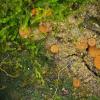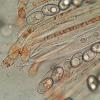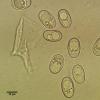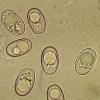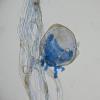
18-12-2025 21:17
Pol DebaenstThe identification took me to Byssonectria deformi

15-12-2025 07:09
 Danny Newman
Danny Newman
indet. Rutstroemiaceae sp. on unk. fallen leavesMc

19-12-2025 10:10
Patrice TANCHAUDBonjour, récolte réalisée en milieu dunaire, a

18-12-2025 17:23
 Bruno Coué
Bruno Coué
Bonjour,je serais heureux d'avoir votre avis sur c

18-12-2025 18:07
Margot en Geert VullingsThese plumes were found on rotten wood.They strong

17-12-2025 18:35
 Michel Hairaud
Michel Hairaud
Bonjour à tous/Hi to everyone I am passing along

15-12-2025 15:48
 Danny Newman
Danny Newman
Melanospora cf. lagenaria on old, rotting, fallen

15-12-2025 15:54
 Johan Boonefaes
Johan Boonefaes
Unknown anamorph found on the ground in coastal sa
Octospora lilacina?
Georges Greiff,
25-11-2021 13:47
I have been sent an interesting Octospora from acidic soil in south west England, growing beside a large patch of the leafy liverwort Solenostoma gracillima and moss protonema (Dicranaceae sp.).
Apothecia orange, margins poorly developed, up to ±1.5mm diam. Asci 8-spored with flat apices. Paraphyses with wide, swollen tips lacking VBs. Ascospores 17.5 - 19.5 x 10.5 - 12.0, with inconspicuously reticulate surface (I think - I have no LCB at the moment to stain).
The best match seems to be O. lilacina, but the apothecia are orange rather than lilac. Other than that, it fits pretty well. Any comments welcome.
Best wishes,
George
Hans-Otto Baral,
25-11-2021 16:25

Re : Octospora lilacina?
My first idea was O. humosa but the apo size and associated mosses contradict this. O. lilacina has hyaline VBs instead of carotenoids.
Georges Greiff,
25-11-2021 16:28
Re : Octospora lilacina?
Thanks, Zotto. Perhaps the host protonema is Pogonatum aloides, where leafy shoots are absent. I agree that it is an odd one.
Jan Eckstein,
31-01-2022 14:37
Re : Octospora lilacina?
Dear George,
your find certainly belongs to the Octospora humosa complex. O. humosa s.str. grows on Polytrichum piliferum but I also know related collections on Atrichum undulatum, Polytrichum formosum, P. longisetum, Pogonatum aloides,P. urnigerum, Oligotrichum hercynicum and even Pogonatum pensylvanicum in North America. Preliminary DNA-studies group the collections according to their host species suggesting a different taxon for each host. Unfortunately, the apothecia can grow with the moss still in protonemal stage, making the identification of the host sometimes impossible. The whole O. humosa complex has a unique infection structure of large globose galls on the rhizoids, whereas the gall surface is free of hyphae (see image). When you find these galls you can be certain it belongs to this group.
With best wishes
Jan

